初中英语课堂教学案例
初中英语课堂教学设计案例优秀9篇

初中英语课堂教学设计案例优秀9篇初中英语课堂教学设计案例篇一一、案例下面以“travels for the environment”为例,对阅读技能训练在教学中的应用加以说明,这篇文章内容含量大,涉及到热门话题——人口与环境,所以我把这篇文章放在初三英语11模块之后讲,在此之前学生在第六模块中谈论到了环保的话题。
我在处理这篇文章时,主要有以下几步:1.阅读前任务设计用多媒体播放,人多车多造成的交通道路拥挤,城市的大面积扩张造成了大面积耕地被占用,森林面积减少,然后提出如下问题:who courses such changes?what should we do?学生马上热烈地讨论起来,屏幕上的场景迅速激活了课堂,激发了学生的阅读兴趣,使他们产生了强烈的阅读愿望。
2.阅读中任务(while-reading task)(1)快速阅读,了解主旨大意(task 1)。
让学生在规定时间内默读完课文并找出每段的主题句或段落的中心句。
当然,学生也可以用不同的句子来概括每段的中心。
只要有自己的观点,都要给予肯定和表扬。
(2)精读,获取更多信息(task 2)。
为了帮助学生了解更多的信息,设计如下几个问题,让学生在文中找出相关信息,并小组讨论:1.From the paage we known that our earth has changed much because of _______. A.its old ageB.man’s activitiesC.the changes of weatherD.the natural development2.Water pollution will bee even worse if __________. A.birds and fish continue to dieB.people continue to built factoriesC.people can’t stop factories from sending waste things into waterD.many rivers and lakes are still dead(3)研读,从中受到启发(task 3)。
初中英语课堂中的情境教学案例

初中英语课堂中的情境教学案例情境教学是一种以情境为背景,以真实或虚构的情境为依据的学习方式。
在初中英语课堂中,情境教学可以帮助学生更好地理解和应用语言知识,提高语言交际能力。
以下是一个关于日常生活情境的英语教学案例。
教学目标:1. 学生能够正确运用一般现在时谈论日常生活习惯。
2. 学生能够就日常生活习惯进行交流和对话。
教学步骤:Step 1: 导入情境教师准备一段视频或图片素材,展示一个典型的日常生活情景,例如起床,吃早餐,上学等,并观察学生对于这些情景的反应和回答,为接下来的讨论做铺垫。
Step 2: 组织学生小组讨论将学生分成小组,每个小组讨论一个日常生活情景,例如家庭就餐,做作业等。
每个小组选择一个学生作为发言人,回答以下问题:- What do you usually do in this situation?(你通常在这种情况下做什么?)- When do you usually do it?(你通常什么时候做这件事?)- How do you feel about it?(你对这件事感觉如何?)Step 3: 小组交流每个小组的发言人依次向全班汇报小组讨论的结果,并和其他小组进行对话和交流,了解不同小组的日常生活习惯有何不同之处。
Step 4: 教师给予相关词汇和句型根据学生的交流内容,教师给予相关的词汇和句型的介绍和讲解,例如:- I usually/always do...(我通常/经常做)- In the morning/afternoon/evening...(在早上/下午/晚上)- I feel...(我感觉...)Step 5: 练习活动教师设计一系列练习活动,鼓励学生运用所学内容进行练习和巩固。
根据给定的情境,学生完成对话,填写空缺词,制作海报等。
Step 6: 情景演练将学生分成小组,每个小组演练一个日常生活情景对话,例如在家庭聚餐时的对话。
鼓励学生使用所学的词汇和句型,通过情景演练提高交际能力。
初中英语课堂中的情境教学案例

初中英语课堂中的情境教学案例情境教学是一种基于实际情境的教学方法,通过设置特定的情境,激发学生的学习兴趣和主动性,提高学习效果。
以下是一个适用于初中英语课堂的情境教学案例。
教学目标:1. 能够用正确的语法和词汇表达自己的感受和观点。
2. 能够用英语进行简单的讨论和交流。
3. 能够使用目标语言描述环境及人物特征。
教学内容:描述人物和环境教学步骤:1. 创造情境:通过一段短视频或者图片描述一个环境,如沙漠、森林等,并其中融入几个人物角色。
提供一些关键词或短语,来帮助学生理解情境。
2. 提问导入:使用问句引入讨论,比如“What is the environment shown in the picture?”,“Who do you think the people are?”等。
鼓励学生积极表达自己的猜测和观点。
3. 分组合作:将学生分成小组,每组让他们讨论并以小组为单位展示自己对环境和人物的描述。
教师可以提供一些问题,如“What do you think the people are doing in the desert?” 或“What do you think their feelings are in this situation?”让学生展开思考讨论。
4. 小组展示:请一些小组将他们的讨论结果分享给全班。
可以让学生使用词汇、短语或者句子来进行描述,可以提供一些句型和词汇的范例,如“The environment looks hot and dry. The people might be feeling thirsty and tired.”等。
5. 整理归纳:让学生总结各组展示的意见,鼓励学生使用目标语言进行归纳和总结。
可以使用思维导图或者整理表格的方式进行整理。
6. 提供反馈:对学生的表现给予适当的反馈,可以是积极的鼓励或指出需要改进之处。
教师可以提供一些额外的信息或案例来扩展学生的知识和思考能力。
初中英语教案范例及讲解
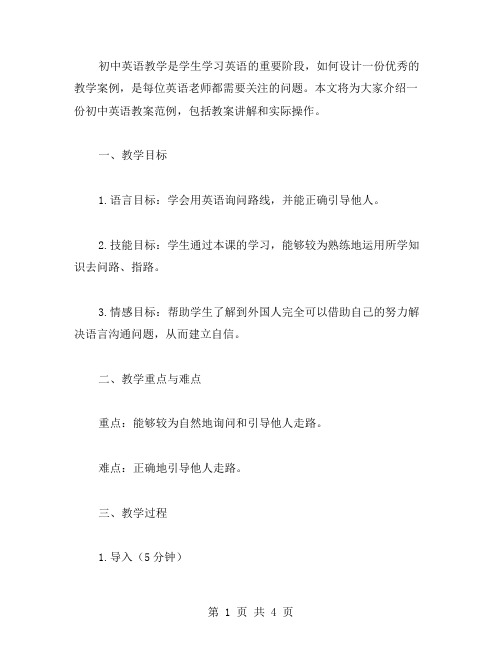
初中英语教学是学生学习英语的重要阶段,如何设计一份优秀的教学案例,是每位英语老师都需要关注的问题。
本文将为大家介绍一份初中英语教案范例,包括教案讲解和实际操作。
一、教学目标1.语言目标:学会用英语询问路线,并能正确引导他人。
2.技能目标:学生通过本课的学习,能够较为熟练地运用所学知识去问路、指路。
3.情感目标:帮助学生了解到外国人完全可以借助自己的努力解决语言沟通问题,从而建立自信。
二、教学重点与难点重点:能够较为自然地询问和引导他人走路。
难点:正确地引导他人走路。
三、教学过程1.导入(5分钟)教师问学生是否知道怎样问路和指路。
请学生自己动手说出一些例句,如:Can you tell me how to get to the park? How can I get to the hospital? 等。
2.新课讲解(10分钟)教师要求学生听一段对话,根据对话内容,总结出关于问路和指路的一些口语表达。
Hello. Excuse me, can you tell me how to get to the museum?Sure. Go straight ahead, and then turn left at the second crossroads, and then the museum will be on your right side.OK. Thank you very much.教师还可以向学生解释一下,为什么要在问路的时候使用“excuse me”这个短语,什么时候该使用“thank you”。
3.练习(20分钟)教师设计两个小组,每组分别有3个学生,其中两个学生充当路人角色,另一个学生为游客角色。
游客向路人A问:“Exc use me, can you tell me how to get to the library?”路人A回答游客,并指示其方向。
游客再向路人B问:“Excuse me, can you tell me how to get to the supermarket?”路人B回答游客,并指示其方向。
初中优秀英文教案

初中优秀英文教案一、教学目标:1. 知识目标:(1)学生能够掌握表示兴趣和爱好的词汇,如draw, paint, play the guitar, read books等。
(2)学生能够运用一般现在时描述自己的兴趣爱好。
(3)学生能够听懂、会说、会读本课的生词和句型。
2. 能力目标:(1)学生能够用英语进行简单的交流,表达自己的兴趣爱好。
(2)学生能够通过合作完成小组活动,提高口语表达能力。
3. 情感目标:(1)培养学生对英语学习的兴趣。
(2)培养学生积极向上的生活态度,鼓励学生培养自己的兴趣爱好。
二、教学重难点:1. 教学重点:(1)学生能够掌握表示兴趣和爱好的词汇。
(2)学生能够运用一般现在时描述自己的兴趣爱好。
(3)学生能够听懂、会说、会读本课的生词和句型。
2. 教学难点:(1)一般现在时的运用。
(2)如何引导学生运用所学知识进行实际交流。
三、教学方法:1. 任务型教学法:通过设置各种任务,让学生在完成任务的过程中运用所学知识,提高语言实际运用能力。
2. 情境教学法:创设各种情境,让学生在真实的环境中感受、理解和学习英语。
3. 小组合作学习:通过小组活动,培养学生团队合作精神,提高口语表达能力。
四、教学过程:1. 热身(5分钟)(1)教师与学生进行简单的英语对话,询问学生周末的活动,引导学生谈论自己的兴趣爱好。
(2)学生进行小组讨论,分享彼此的兴趣爱好。
2. 呈现(10分钟)(1)教师展示本课的生词和句型,如“I like playing soccer.”“She enjoys reading books.”等。
(2)学生跟读生词和句型,教师纠正发音。
3. 练习(15分钟)(1)学生进行听力练习,听录音并模仿发音。
(2)学生进行口语练习,用所学句型描述自己的兴趣爱好。
4. 任务(15分钟)(1)学生分组,每组选择一个兴趣爱好,如drawing, playing soccer等。
(2)每组用英语讨论自己的兴趣爱好,并准备进行汇报。
初中英语教学案例模板范文

初中英语教学案例模板范文一、教学背景这是一节针对初中学生的英语课程,学生平均年龄为13岁,班级总人数为30人。
教室配备了多媒体教学设备,教学条件较为优越。
二、教学目标1.能够熟练掌握本节课所学习的英语单词和句型。
2.能够在日常生活中运用所学英语表达简单的观点和意见。
3.能够在课堂角色扮演活动中积极参与,提高口语表达能力。
三、教学准备1.备课教师准备了课程教案、多媒体教学课件和相关教学资料。
2.确保教室内多媒体设备工作正常。
3.准备了学生需要用到的练习册和笔。
四、教学过程1. Warm-up (5 minutes)教师通过播放一段有关日常生活的英语短视频来激发学生学习英语的兴趣,并导入本节课的主题。
2. Presentation (15 minutes)教师通过多媒体课件展示本节课所学的单词和句型,并进行解释和示范,让学生理解并掌握所学内容。
3. Practice (20 minutes)学生分组进行口语练习,通过小组互动,练习所学单词和句型,并进行扮演对话练习,提高口语表达能力。
4. Consolidation (10 minutes)教师设计练习题让学生巩固所学内容,比如填空题、选择题等,巩固学生的知识点。
5. Production (10 minutes)学生进行角色扮演活动,运用所学内容进行真实情景对话练习,培养学生英语交流能力。
6. Summary (5 minutes)教师对本节课的重点内容进行总结,并鼓励学生在课下多加练习,巩固所学知识。
五、教学评价本节课通过多种形式的教学活动,激发学生学习英语的兴趣,提高了学生的口语表达能力和综合运用能力。
教师认为学生在本节课中的表现积极,对英语学习有很好的态度。
六、教学反思教师在教学过程中发现学生对角色扮演活动表现较好,但对部分单词的记忆还不够扎实,下节课将针对这一问题增加相应的记忆训练。
以上是本节课的教学案例模板范文,学生在本节课中积极参与,取得了一定的进步。
双减背景下初中英语课堂教学案例

双减背景下初中英语课堂教学案例English: With the background of "double reduction" (reducing the academic burden on students and the excessive social activities), the teaching objectives of middle school English classes should focus on cultivating students' comprehensive abilities in language application, critical thinking, and communication skills. In order to achieve these objectives, teachers can design a variety of interactive and hands-on activities, such as group discussions, project-based learning, role-playing, and language games. For example, when teaching a reading passage, teachers can organize group discussions to encourage students to analyze the text critically and express their opinions effectively. In addition, incorporating real-life scenarios and multimedia resources into the lessons can help increase students' interest and motivation in learning English. By creating an immersive and supportive learning environment, students will be more actively engaged in the learning process and develop a more profound understanding of the language and culture.中文翻译:在“双减”(减轻学生的学业负担和过多的社会活动)的背景下,初中英语课堂的教学目标应集中在培养学生语言运用、批判性思维和沟通能力方面的综合能力。
初中英语教学案例分析100例
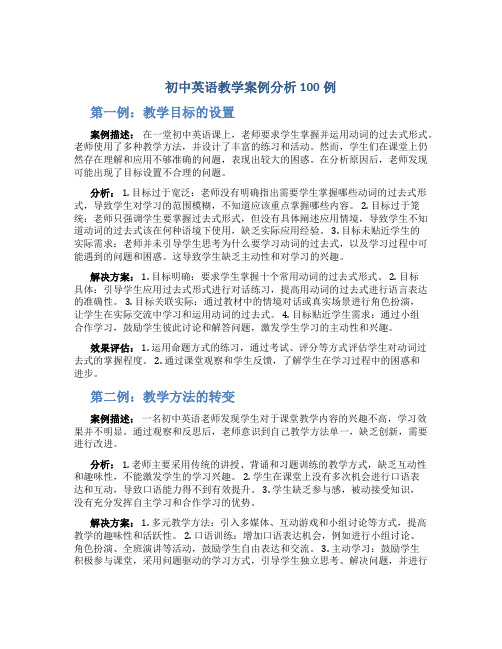
初中英语教学案例分析100例第一例:教学目标的设置案例描述:在一堂初中英语课上,老师要求学生掌握并运用动词的过去式形式。
老师使用了多种教学方法,并设计了丰富的练习和活动。
然而,学生们在课堂上仍然存在理解和应用不够准确的问题,表现出较大的困惑。
在分析原因后,老师发现可能出现了目标设置不合理的问题。
分析: 1. 目标过于宽泛:老师没有明确指出需要学生掌握哪些动词的过去式形式,导致学生对学习的范围模糊,不知道应该重点掌握哪些内容。
2. 目标过于笼统:老师只强调学生要掌握过去式形式,但没有具体阐述应用情境,导致学生不知道动词的过去式该在何种语境下使用,缺乏实际应用经验。
3. 目标未贴近学生的实际需求:老师并未引导学生思考为什么要学习动词的过去式,以及学习过程中可能遇到的问题和困惑。
这导致学生缺乏主动性和对学习的兴趣。
解决方案: 1. 目标明确:要求学生掌握十个常用动词的过去式形式。
2. 目标具体:引导学生应用过去式形式进行对话练习,提高用动词的过去式进行语言表达的准确性。
3. 目标关联实际:通过教材中的情境对话或真实场景进行角色扮演,让学生在实际交流中学习和运用动词的过去式。
4. 目标贴近学生需求:通过小组合作学习,鼓励学生彼此讨论和解答问题,激发学生学习的主动性和兴趣。
效果评估: 1. 运用命题方式的练习,通过考试、评分等方式评估学生对动词过去式的掌握程度。
2. 通过课堂观察和学生反馈,了解学生在学习过程中的困惑和进步。
第二例:教学方法的转变案例描述:一名初中英语老师发现学生对于课堂教学内容的兴趣不高,学习效果并不明显。
通过观察和反思后,老师意识到自己教学方法单一,缺乏创新,需要进行改进。
分析: 1. 老师主要采用传统的讲授、背诵和习题训练的教学方式,缺乏互动性和趣味性,不能激发学生的学习兴趣。
2. 学生在课堂上没有多次机会进行口语表达和互动,导致口语能力得不到有效提升。
3. 学生缺乏参与感,被动接受知识,没有充分发挥自主学习和合作学习的优势。
对分课堂初中英语新授课教学设计案例

对分课堂初中英语新授课教学设计案例九年级上册第二单元I. The analysis of content内容解析本课是九年级第二单元第二话题的第一课时。
主活动是1a。
1a通过Kangkang 向他的同伴Maria和Jane抱怨恶劣的天气,引出本课的功能意念:抱怨和责备。
同时也初步呈现了本单元的语法点:不定代词和不定副词。
1b主要培养听力策略,即重点听对话的大意。
1c侧重于考查归纳总结的能力。
本课通过谈论沙尘暴的成因说明了树木对环境保护的重要作用。
同时也让学生了解天气与人类活动的关系,关注全球的环境问题。
II.The analysis of objectives目标解析通过1a的学习,掌握本课的重点词汇和短语,初步感知不定代词和不定副词的用法。
谈论沙尘暴的成因。
对沙尘暴了解,能够根据图片和信息提示词描述沙尘暴形成的过程。
让学生了解环境污染的严峻形势,引导学生爱护大自然,爱护花草树木,树立绿色环保意识。
III. Teaching objectives教学目标1.掌握下列①单词和短语:sand,although,sandstorm,desert,human being,reduce,completely,change into,stop … from,blow/ wash … away,as a result②句型:A lot of water can be saved by forests.Although we have built “The Green Great Wall”,we still need to do something to protect the environment.2.語法:在对话中掌握不定代词和副词的用法。
3.能够从所听材料中获得有效的细节信息来补全句子。
4.能够根据图片和信息提示词描述沙尘暴形成的过程。
IV. Key points教学重点1.能够从所听材料中获得有效的细节信息来补全句子。
初中英语课堂中的情境教学案例

初中英语课堂中的情境教学案例1. 引言1.1 初中英语课堂中的情境教学案例In the middle school English classroom, situational teaching cases play a crucial role in enhancing students' language learning experiences. Through various real-life scenarios and interactive activities, students are able to engage in authentic language use and apply their language skills in practical situations. Situational teaching not only helps students improve their language proficiency but also fosters their confidence in using English in different contexts.2. 正文2.1 概述情境教学在英语教学中的重要性情境教学在英语教学中扮演着重要的角色,它通过创造真实的语言环境,让学生在实际交流中学习语言,提高他们的语言表达能力和交际技能。
通过情境教学,学生能够更好地理解词汇和语法的运用,提高语言的听说读写能力。
情境教学可以激发学生学习英语的兴趣和动力,让他们更愿意参与课堂活动,积极地学习和运用语言知识。
在情境教学中,学生可以通过角色扮演、真实场景模拟、多媒体技术等方式,更好地理解和运用英语,提高他们的学习效果。
情境教学还可以培养学生的合作精神和团队意识,通过小组活动让学生在合作中学习语言技能,提高他们的沟通能力和解决问题的能力。
2.2 案例一:通过角色扮演提高学生口语表达能力角色扮演是一种常见的情境教学方法,在初中英语课堂中被广泛应用。
初中英语教案设计范例
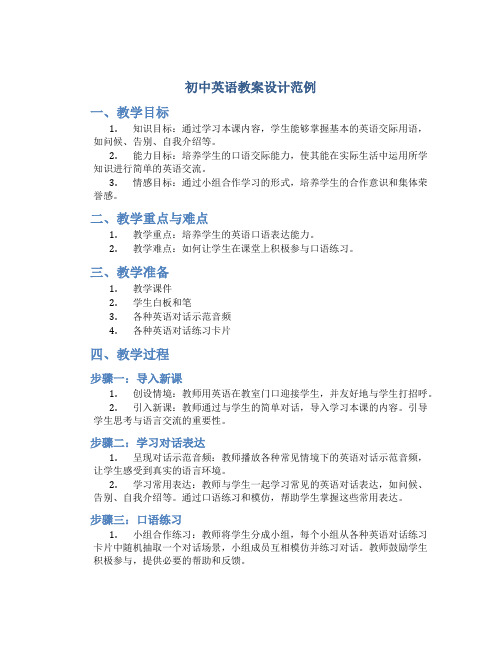
初中英语教案设计范例一、教学目标1.知识目标:通过学习本课内容,学生能够掌握基本的英语交际用语,如问候、告别、自我介绍等。
2.能力目标:培养学生的口语交际能力,使其能在实际生活中运用所学知识进行简单的英语交流。
3.情感目标:通过小组合作学习的形式,培养学生的合作意识和集体荣誉感。
二、教学重点与难点1.教学重点:培养学生的英语口语表达能力。
2.教学难点:如何让学生在课堂上积极参与口语练习。
三、教学准备1.教学课件2.学生白板和笔3.各种英语对话示范音频4.各种英语对话练习卡片四、教学过程步骤一:导入新课1.创设情境:教师用英语在教室门口迎接学生,并友好地与学生打招呼。
2.引入新课:教师通过与学生的简单对话,导入学习本课的内容。
引导学生思考与语言交流的重要性。
步骤二:学习对话表达1.呈现对话示范音频:教师播放各种常见情境下的英语对话示范音频,让学生感受到真实的语言环境。
2.学习常用表达:教师与学生一起学习常见的英语对话表达,如问候、告别、自我介绍等。
通过口语练习和模仿,帮助学生掌握这些常用表达。
步骤三:口语练习1.小组合作练习:教师将学生分成小组,每个小组从各种英语对话练习卡片中随机抽取一个对话场景,小组成员互相模仿并练习对话。
教师鼓励学生积极参与,提供必要的帮助和反馈。
2.报告演示:每个小组选派一名代表,向全班展示他们的对话练习成果。
教师对每个小组的表现给予评价和指导。
步骤四:拓展练习1.学生交流:教师让学生自由选择搭档,进行自由对话练习。
鼓励学生使用课堂上学到的对话表达,自由发挥,创造语言环境。
2.教师巡回指导:教师在课堂上巡回指导学生的练习,给予及时的鼓励和帮助。
五、教学总结1.巩固知识:教师对本课所学内容进行总结,并复习了重点表达。
2.评价反馈:教师根据学生的表现给予评价,表扬优秀的学生并帮助其他学生纠正错误。
六、课后作业将学到的对话表达写成对话小剧本,进行拓展练习。
下节课时,学生可以进行表演,展示自己的创作和口语表达能力。
初中英语课堂中的情境教学案例
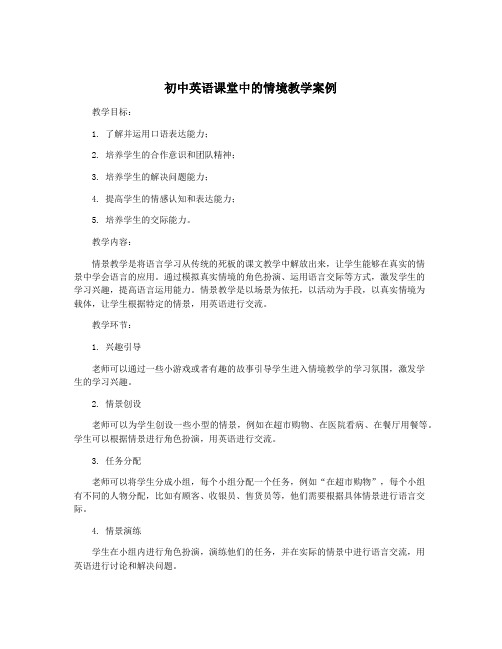
初中英语课堂中的情境教学案例教学目标:1. 了解并运用口语表达能力;2. 培养学生的合作意识和团队精神;3. 培养学生的解决问题能力;4. 提高学生的情感认知和表达能力;5. 培养学生的交际能力。
教学内容:情景教学是将语言学习从传统的死板的课文教学中解放出来,让学生能够在真实的情景中学会语言的应用。
通过模拟真实情境的角色扮演、运用语言交际等方式,激发学生的学习兴趣,提高语言运用能力。
情景教学是以场景为依托,以活动为手段,以真实情境为载体,让学生根据特定的情景,用英语进行交流。
教学环节:1. 兴趣引导老师可以通过一些小游戏或者有趣的故事引导学生进入情境教学的学习氛围,激发学生的学习兴趣。
2. 情景创设老师可以为学生创设一些小型的情景,例如在超市购物、在医院看病、在餐厅用餐等。
学生可以根据情景进行角色扮演,用英语进行交流。
3. 任务分配老师可以将学生分成小组,每个小组分配一个任务,例如“在超市购物”,每个小组有不同的人物分配,比如有顾客、收银员、售货员等,他们需要根据具体情景进行语言交际。
4. 情景演练学生在小组内进行角色扮演,演练他们的任务,并在实际的情景中进行语言交流,用英语进行讨论和解决问题。
5. 展示交流每个小组可以在课堂上展示他们的情景演练,让其他同学和老师一起观看,评价他们的表现,并学习其他小组的表现。
6. 总结反思在展示之后,老师可以与学生一起总结这次情景教学的经验和不足,让学生回顾自己的表现,反思自己的不足之处,为下一次情景教学作准备。
案例一:在饭店用餐情景创设:模拟在饭店用餐的情景,学生分成小组,每个小组分配一个角色,有顾客、服务员、厨师等。
任务分配:每个小组根据具体的情景,确定每个人的角色和对话内容。
情景演练:在角色扮演的情景中,学生进行语言交际,模拟真实的用餐情景,进行英语交流。
展示交流:每个小组在课堂上进行角色扮演,展示他们的用餐情景,并接受其他同学和老师的评价。
总结反思:学生进行角色扮演后,老师与学生一起总结这次用餐情景的经验和不足,让学生回顾自己的表现,反思自己的不足之处,为下一次情景教学作准备。
初中英语课堂教学实录四篇

初中英语课堂教学实录四篇第一篇: 初中英语课堂教学实录 xx老师执教的这一堂课是一堂清晰实在,扎实系统,动静结合的小学英语课。
教师以新的课程理念为指导,充分考虑儿童的年龄特点,在本课的教学设计和组织上注重了以下几个方面。
1、注重创新情景,体现了以情景为主线。
本节课主要通过创设情景来传授新知。
可以说新颖的情景再现,充分调动起学生兴趣。
良好的开头对一堂课的成功与否,起着关键的作用。
xx老师利用学过的职业话题,很自然的过度,引出新课,具有温故引新的效果。
2、关注教学方法,体现了一个“活”字。
教师的教学方法灵活,新内容呈现形式多样。
让学生根据挂图自然切入,通过对话灵活学习。
播放录像,听力练习;英汉互译,巩固新知。
这些多样的教学方式极大的调动了学生学习的积极性,营造了良好的课堂氛围。
总之,李xx老师能贯彻以学生为中心的原则,关注教学过程,尽可能发挥学生的主体作用,让学生真实的去感受知识,体验知识,积极参与,努力实践,在活动中学会用语言表达交流,较好的体现了从不懂到懂,从不会到会,从不熟练到熟练的过程。
第二篇: 初中英语课堂教学实录初中青年英语教师听课活动已经圆满结束,这次活动为我们教师业务素质的提高提供了一次不可多得的学习机会,作为一名英语教师,我深受启发,每一节课都有很多值得我们学习借鉴的东西,真可谓受益匪浅,下面就谈谈我在英语方面的一点听课感受:一、教师自身的良好素质是上好一堂课的重要前提和基本保证在听课中,我发现优秀的教师都有几个共同特点:1、口语流利,发音准确。
只有做到这一点,才能保证孩子对课程的理解,才能保证孩子学到正确的知识,地道的语言;2、善于利用多种手段辅助教学,使孩子接触到的知识更立体,更直观,更生动;3、教态亲切,表情丰富,在课堂上能轻松,活泼,潇洒地进行授课,富有艺术性;4、有扎实的英语基础知识作为后盾,词汇丰富,课堂充实。
二、调动学生积极性,让学生真正成为课堂的主人这是新课标的重要特点,也是素质教育的要求。
初中真实英语授课教案
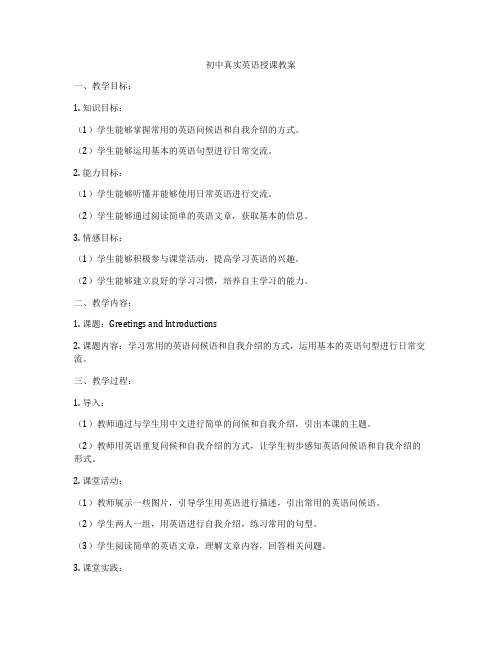
初中真实英语授课教案一、教学目标:1. 知识目标:(1)学生能够掌握常用的英语问候语和自我介绍的方式。
(2)学生能够运用基本的英语句型进行日常交流。
2. 能力目标:(1)学生能够听懂并能够使用日常英语进行交流。
(2)学生能够通过阅读简单的英语文章,获取基本的信息。
3. 情感目标:(1)学生能够积极参与课堂活动,提高学习英语的兴趣。
(2)学生能够建立良好的学习习惯,培养自主学习的能力。
二、教学内容:1. 课题:Greetings and Introductions2. 课题内容:学习常用的英语问候语和自我介绍的方式,运用基本的英语句型进行日常交流。
三、教学过程:1. 导入:(1)教师通过与学生用中文进行简单的问候和自我介绍,引出本课的主题。
(2)教师用英语重复问候和自我介绍的方式,让学生初步感知英语问候语和自我介绍的形式。
2. 课堂活动:(1)教师展示一些图片,引导学生用英语进行描述,引出常用的英语问候语。
(2)学生两人一组,用英语进行自我介绍,练习常用的句型。
(3)学生阅读简单的英语文章,理解文章内容,回答相关问题。
3. 课堂实践:(1)学生进行角色扮演,模拟日常生活中的场景,运用所学的英语句型进行交流。
(2)学生分组进行讨论,讨论如何用英语进行有效的自我介绍。
四、作业布置:1. 学生回家后,用英语向家人问好并进行自我介绍。
2. 学生阅读一篇简单的英语文章,并回答相关问题。
五、教学反思:通过本节课的学习,学生能够掌握常用的英语问候语和自我介绍的方式,运用基本的英语句型进行日常交流。
教师应及时对学生的学习情况进行反馈,鼓励学生积极参与课堂活动,提高学习英语的兴趣。
同时,教师也应关注学生的个体差异,因材施教,使每个学生都能在课堂上得到锻炼和提高。
初中英语课堂中的情境教学案例
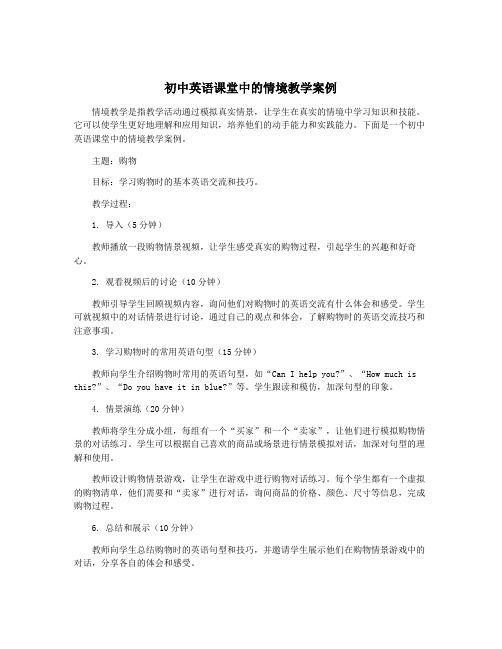
初中英语课堂中的情境教学案例情境教学是指教学活动通过模拟真实情景,让学生在真实的情境中学习知识和技能。
它可以使学生更好地理解和应用知识,培养他们的动手能力和实践能力。
下面是一个初中英语课堂中的情境教学案例。
主题:购物目标:学习购物时的基本英语交流和技巧。
教学过程:1. 导入(5分钟)教师播放一段购物情景视频,让学生感受真实的购物过程,引起学生的兴趣和好奇心。
2. 观看视频后的讨论(10分钟)教师引导学生回顾视频内容,询问他们对购物时的英语交流有什么体会和感受。
学生可就视频中的对话情景进行讨论,通过自己的观点和体会,了解购物时的英语交流技巧和注意事项。
3. 学习购物时的常用英语句型(15分钟)教师向学生介绍购物时常用的英语句型,如“Can I help you?”、“How much is this?”、“Do you have it in blue?”等。
学生跟读和模仿,加深句型的印象。
4. 情景演练(20分钟)教师将学生分成小组,每组有一个“买家”和一个“卖家”,让他们进行模拟购物情景的对话练习。
学生可以根据自己喜欢的商品或场景进行情景模拟对话,加深对句型的理解和使用。
教师设计购物情景游戏,让学生在游戏中进行购物对话练习。
每个学生都有一个虚拟的购物清单,他们需要和“卖家”进行对话,询问商品的价格、颜色、尺寸等信息,完成购物过程。
6. 总结和展示(10分钟)教师向学生总结购物时的英语句型和技巧,并邀请学生展示他们在购物情景游戏中的对话,分享各自的体会和感受。
教师布置作业,要求学生根据自己的实际经历或想象,写一篇关于购物经历的英语作文。
作文内容包括购物的场景、对话以及自己的感受和体会。
初中英语三学课堂教案模板
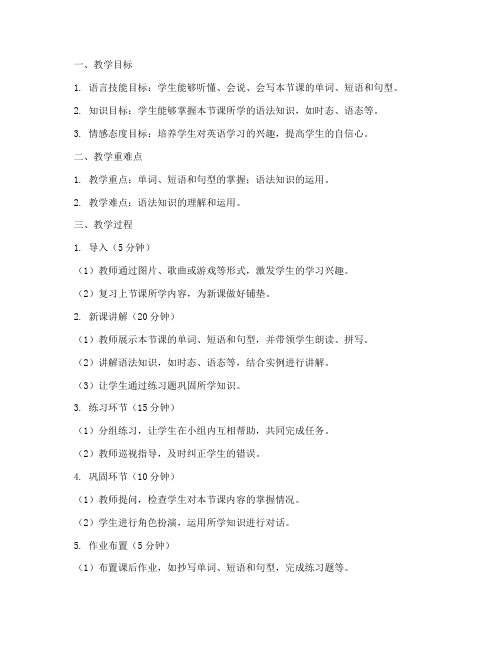
一、教学目标1. 语言技能目标:学生能够听懂、会说、会写本节课的单词、短语和句型。
2. 知识目标:学生能够掌握本节课所学的语法知识,如时态、语态等。
3. 情感态度目标:培养学生对英语学习的兴趣,提高学生的自信心。
二、教学重难点1. 教学重点:单词、短语和句型的掌握;语法知识的运用。
2. 教学难点:语法知识的理解和运用。
三、教学过程1. 导入(5分钟)(1)教师通过图片、歌曲或游戏等形式,激发学生的学习兴趣。
(2)复习上节课所学内容,为新课做好铺垫。
2. 新课讲解(20分钟)(1)教师展示本节课的单词、短语和句型,并带领学生朗读、拼写。
(2)讲解语法知识,如时态、语态等,结合实例进行讲解。
(3)让学生通过练习题巩固所学知识。
3. 练习环节(15分钟)(1)分组练习,让学生在小组内互相帮助,共同完成任务。
(2)教师巡视指导,及时纠正学生的错误。
4. 巩固环节(10分钟)(1)教师提问,检查学生对本节课内容的掌握情况。
(2)学生进行角色扮演,运用所学知识进行对话。
5. 作业布置(5分钟)(1)布置课后作业,如抄写单词、短语和句型,完成练习题等。
(2)提醒学生按时完成作业,并做好复习。
四、教学评价1. 课堂表现:观察学生在课堂上的参与度、合作能力和表达能力。
2. 作业完成情况:检查学生的课后作业,了解学生对本节课内容的掌握程度。
3. 期末考试:通过考试评估学生对本学期所学知识的掌握情况。
五、教学反思1. 教师应关注学生的学习需求,调整教学策略,提高教学质量。
2. 注重学生的个体差异,因材施教,使每个学生都能在英语学习中取得进步。
3. 创设轻松、愉快的课堂氛围,激发学生的学习兴趣,提高学生的英语素养。
以下为初中英语三学课堂教案模板的示例:课题:Unit 1 My name is Gina.教学目标:1. 语言技能目标:学生能够听懂、会说、会写本节课的单词、短语和句型。
2. 知识目标:学生能够掌握一般现在时的用法。
初二英语教学案例范文(实用精选8篇

初二英语教学案例范文(实用精选8篇(经典版)编制人:__________________审核人:__________________审批人:__________________编制单位:__________________编制时间:____年____月____日序言下载提示:该文档是本店铺精心编制而成的,希望大家下载后,能够帮助大家解决实际问题。
文档下载后可定制修改,请根据实际需要进行调整和使用,谢谢!并且,本店铺为大家提供各种类型的经典范文,如总结报告、演讲发言、策划方案、合同协议、心得体会、计划规划、应急预案、教学资料、作文大全、其他范文等等,想了解不同范文格式和写法,敬请关注!Download tips: This document is carefully compiled by this editor. I hope that after you download it, it can help you solve practical problems. The document can be customized and modified after downloading, please adjust and use it according to actual needs, thank you!Moreover, our store provides various types of classic sample essays, such as summary reports, speeches, planning plans, contract agreements, insights, planning, emergency plans, teaching materials, essay summaries, and other sample essays. If you want to learn about different sample formats and writing methods, please pay attention!初二英语教学案例范文(实用精选8篇通过各类这些国家的印刷和电子媒体,英语已成为国际主导语言之一、在许多地区和专业的环境下的语言也有主导地位。
新课程标准下初中英语课堂教学有效探究的教学案例
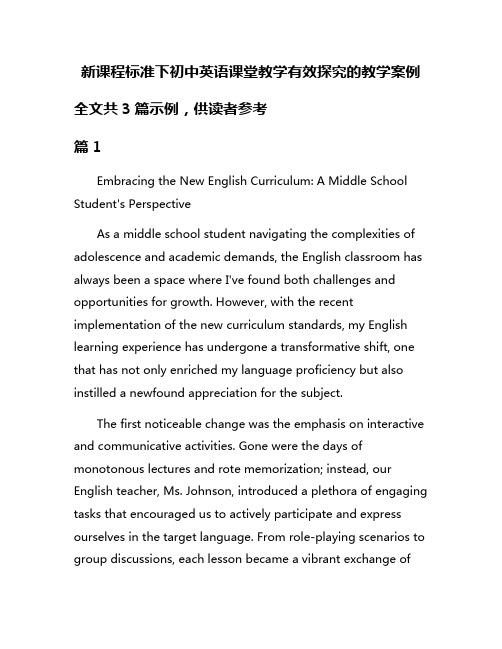
新课程标准下初中英语课堂教学有效探究的教学案例全文共3篇示例,供读者参考篇1Embracing the New English Curriculum: A Middle School Student's PerspectiveAs a middle school student navigating the complexities of adolescence and academic demands, the English classroom has always been a space where I've found both challenges and opportunities for growth. However, with the recent implementation of the new curriculum standards, my English learning experience has undergone a transformative shift, one that has not only enriched my language proficiency but also instilled a newfound appreciation for the subject.The first noticeable change was the emphasis on interactive and communicative activities. Gone were the days of monotonous lectures and rote memorization; instead, our English teacher, Ms. Johnson, introduced a plethora of engaging tasks that encouraged us to actively participate and express ourselves in the target language. From role-playing scenarios to group discussions, each lesson became a vibrant exchange ofideas and perspectives, fostering a supportive environment where we could practice our speaking skills without fear of judgment.One particular activity that stands out in my mind was the "Cultural Ambassadors" project. In groups, we were tasked with researching and presenting on various aspects ofEnglish-speaking cultures, ranging from traditions and customs to art and literature. This not only allowed us to delve deeper into the cultural richness associated with the language but also challenged us to think critically, synthesize information, and effectively communicate our findings to our peers. The experience was both educational and empowering, as we gained a broader understanding of the world beyond our immediate surroundings.Another significant shift under the new curriculum was the integration of technology into our English lessons. Ms. Johnson embraced the digital age by incorporating multimedia resources, educational apps, and online platforms into our learning experience. We used language-learning apps to practice vocabulary and grammar exercises, watched authentic video clips to explore real-life contexts, and even participated in virtual language exchanges with students from other countries. Thisseamless blend of traditional and modern teaching methods not only made the lessons more engaging but also prepared us for the increasingly digitized world we live in.Moreover, the new curriculum emphasized the development of critical thinking and problem-solving skills, moving away from the traditional focus on passive knowledge acquisition. We were regularly presented with open-ended tasks andthought-provoking questions that challenged us to analyze, evaluate, and formulate well-reasoned arguments. For instance, during our literature study of a classic novel, we engaged in lively debates and discussions, exploring the deeper themes and underlying messages conveyed by the author. These experiences not only deepened our understanding of the English language but also honed our ability to think critically and articulate our thoughts coherently.Perhaps one of the most significant impacts of the new curriculum was the emphasis on personalized learning and differentiated instruction. Ms. Johnson made a conscious effort to understand our individual strengths, weaknesses, and learning styles, tailoring her teaching methods accordingly. For those who excelled in certain areas, she provided additional challenges and enrichment opportunities, while offering extra support andguidance to those who needed it. This personalized approach ensured that no student was left behind and that we all had the opportunity to reach our full potential.Furthermore, the new curriculum encouraged us to take ownership of our learning journey. We were encouraged to set personal goals, reflect on our progress, and actively seek out additional resources and opportunities for practice. This fostered a sense of responsibility and self-motivation, qualities that will undoubtedly serve us well in our future academic and professional endeavors.Looking back on my middle school English experience under the new curriculum, I can confidently say that it has been a transformative and empowering journey. The emphasis on interactive and communicative activities, the integration of technology, the development of critical thinking skills, personalized learning, and student ownership have all contributed to a more engaging, relevant, and meaningful language learning experience.As I prepare to transition to high school, I feel well-equipped with the necessary language proficiency and transferable skills to navigate the challenges that lie ahead. The new curriculum has not only provided me with a solid foundation in English but hasalso instilled in me a lifelong love for learning and a curiosity about the world around me.While the path ahead may be uncertain, one thing is clear: the new English curriculum has equipped me with the tools and mindset to embrace the challenges of the future with confidence and resilience. I am grateful for the dedication and innovative approach of educators like Ms. Johnson, who have made this transformative learning experience possible. As I embark on the next chapter of my academic journey, I carry with me the invaluable lessons and skills acquired through this dynamic and engaging English curriculum.篇2A Case Study on Effective English Teaching in Middle School Under the New Curriculum StandardsAs an 8th grade student, I have experienced quite a few changes in how English is taught in my middle school over the past few years. Our school has adopted the new national curriculum standards for English education, and this has really transformed the English classroom. In my opinion, the new teaching methods are much more effective in helping students like myself build real-world English skills.The biggest shift I've noticed is that English classes now focus heavily on practical communication abilities rather than just rote memorization of vocabulary and grammar rules. When I was in 6th grade, most of our English classes revolved around copying down long lists of words and their definitions, filling out worksheets of sentence patterns, and preparing for tests where we had to recite all that information back.Now in 8th grade, our classes look completely different. There is still some vocabulary and grammar instruction, but it is always tied to authentic language use through activities like role-plays, discussions, presentations, and project work. For example, when recently learning about giving directions, we didn't just memorize prepositions and sentence frames. Instead, we played games working in pairs to direct each other to different locations around the school using those language forms. We also did a mapping project where we had to give written and spoken directions for how to get to different places in our city.This application-focused approach has helped me actually learn how to use English to communicate, not just recognize the linguistic forms. I feel much more confident now about understanding English audio or video and expressing myself,whereas before I could fill out grammar exercises accurately but froze up when trying to have a real conversation.Another major change is how our teachers integrate more culturally authentic English resources and tasks into the lessons nowadays. Instead of just following the textbook dialog passages written specifically for a Chinese audience, we explore things like English books, websites, music, TV shows, and movies from places like the US, UK, Australia, and other countries. Our teacher has us listen to podcasts, read short stories, analyze advertisements, and discuss current events and cross-cultural experiences.Getting this kind of rich exposure to real English content makes the language feel much more relevant, useful and interesting to me. When I encounter English in my life outside of school through media, travel, or interaction with native speakers, I'm able to engage with it more seamlessly. Before, English always felt like an artificial construct - now I truly see it as a vital means of global communication and connection to the world beyond China.Admittedly, these new teaching methods require much more active participation, critical thinking, and output from students. It's not just listening to the teacher explain and thenmechanically copying down notes anymore. We have to constantly use English to collaborate, debate, create, and solve problems through group discussions, research projects, and presentations. At first this learning style was quite challenging for me because I was so accustomed to the passive reception of knowledge.However, as I've grown more acclimated to this participatory approach, I realize how valuable those skills are. Not only am I becoming a stronger English speaker, writer, and thinker, but I'm building lasting competencies in communication, teamwork, researching, organizing ideas, and public speaking. These are universally applicable assets that will serve me well in any future academic or career path. The old teaching methods never gave me an opportunity to practice and develop those real-world capabilities alongside the language itself.One concern I've heard raised is that this more open-ended, exploratory style of learning could mean sacrificing mastery of the core grammar, vocabulary, and test-taking abilities required to perform well on the high-stakes English exams in high school and university. After篇3A Case Study on Effective Middle School English Instruction Under the New StandardsAs an 8th grader, I've experienced quite a few different English teachers and classroom approaches over the years. This year, with the new national curriculum standards being implemented, my English class has taken on a refreshing new style that I find much more engaging and effective. Let me walk you through what a typical lesson looks like now.The class always starts with my teacher Ms. Wang greeting us warmly and getting us energized through an interactive warm-up activity. One day she had us go around making sentences using vocabulary words we had learned, giving points for using them correctly in context. Another time she had us practice conversational scenarios like ordering at a restaurant. These short activities really get our minds turned on and ready to dive into the main lesson content.Rather than just lecturing at us, Ms. Wang makes sure we are constantly interacting and actively using the language. When we started the unit on writing emails, she put us into pairs and had us compose an email to a friend describing our weekend plans. We worked together to choose the appropriate language,formality, and structure. Then volunteer pairs read their emails aloud and we gave feedback as a class.For the reading lessons, we never just do rote comprehension questions. Ms. Wang has us analyze the textsin-depth, identifying themes, making inferences about characters' motivations, and applying the content to our own lives. For example, when we read a passage about a student stressed about exams, we related it to our own experiences and wrote journal entries from that perspective. Activities like this make the texts feel much more relevant and meaningful.The grammar instruction is also interactive rather than just rote memorization and drills. When we were studying the different verb tenses, we did an activity where we had to walk around the classroom acting out actions happening in the present, past, or future. Then we had to describe what each other was doing or did using the proper tenses. It was a fun way to build a physical association with how to properly use each tense.One of the biggest changes I've noticed is how much more we get to apply our English skills to real-world situations and our own interests. For the unit on giving instructions and descriptions, we first watched video tutorials for things like baking a cake or changing a bike tire. Then we choose somethingwe were knowledgeable about, like a sport or hobby, and each created our own how-to video providing step-by-step instructions.We've also done debate units where we had to research and discuss issues relevant to youth like school policies or environmental topics. Not only did this improve our argumentative skills, but it allowed us to explore content we were genuinely curious about and had strong opinions on.I really appreciate how much more autonomy and freedom of expression Ms. Wang gives us now too. Rather than always following a rigid textbook curriculum, she designs tasks that allow us to choose our own topics and formats for projects when possible. For example, for our creative writing unit, we could pick any genre of writing we wanted like a short story, poem, comic book script, etc.We even have opportunities to give input on how we would like to conduct certain lessons and activities. Recently when we were planning how to practice our presentation skills, Ms. Wang had us vote on whether we wanted to give individual speeches, work in groups, or film video presentations. This democracy in the classroom makes us much more invested in the learning process.My classmates and I look forward to English class now in a way we never really did before. The interactive teaching style keeps us engaged, the meaningful real-world applications make the lessons feel relevant, and the autonomy Ms. Wang gives us makes us feel respected as learners with our own voices.I'm understanding and retaining the material better than ever before too. Instead of just cramming for tests, the interactive tasks are reinforcing what we've learned in a deeper, more lasting way. I've found myself naturally incorporating new vocabulary and expressions into my conversations and creative writing outside of class.The new standards Ms. Wang is following clearly put a huge emphasis on building overall communicative competence and meaningful interaction with the language. Long gone are the days of just drilling grammar rules and antiquated textbook exercises. We are utilizing English in the same ways we would in real-world scenarios at an appropriate level for our age.I can definitely see how an approach like this is progressively building our listening, speaking, reading, and writing abilities in a more cohesive and practical manner. Even though the workload is arguably higher than just doing rote exercises, the learning just sticks better and feels more relevant and purposeful.While initially a bit overwhelming for both my teacher and our class to adapt to the new standards, we've settled into these new methods nicely. As long as teachers continue training in and evolving these best practices, I'm confident the new curriculum will be successful in producing a new generation of English learners who are truly skilled communicators in the language.。
初三英语教学案例优秀6篇

初三英语教学案例优秀6篇初三英语教学案例篇一【关键词】小学英语课堂教学教学效益对策小学英语课程是我国基础教育课程的重要内容。
城市的小学英语教学工作在素质教育和课程改革开展得较好。
然而,农村小学英语教学的现状却远不如人意。
英语不用我再强调它的重要性,看看小学生就知道,已经从三年级开始学习。
对于那些城市中的孩子,电脑,各种先进的辅导用书,学习软件数不胜数,已经形成良好的学习环境。
四年的英语学习,已经让他们很好的适应初中学习。
可还有一些现象,农村来的孩子往往差在英语,要不是专门成立一个班,加强英语;要不是成为初三拉腿的科目。
追溯根源,小学英语没有学,或没有成为一门正式科目。
农村小学英语所面临的问题:一、农村小学不重视英语学习虽然新课改已实施,但在农村小学并没有真正开展落实。
在城市小学,小学英语起始年级为三年级,每周四次教学活动。
但在一些农村小学对英语不重视,很少开齐课程。
有的从三年级开始,有的则是五年级,有的干脆没有开设。
即使开设课程,也如同虚设。
把英语当成一门“副课”或当成一门兴趣课。
这样一来,城乡小学英语教学水平就产生相当大的差距。
到了初中,由于城市与农村英语学习成绩的不平衡,给老师授课带来了很大麻烦,导致初中偏科或两级分化现象的产生。
二、教学资源贫乏,没有良好的语言学习环境相比城市优越的教学环境,在农村小学更不要提多媒体,语音室了。
有些偏远的地方连练习册都没有配齐。
学生处在这样的自然环境中,没有一定的语言环境。
“听不懂、说不出、读不快、写不好”等现象普遍存在。
在设备缺乏的情况下,为了提高课堂效率,培养学生对英语的兴趣。
将枯燥的“添鸭式”学习,变成主动的兴趣学习。
将课堂调动起来,把课堂还给学生。
为此,在本学期刚开学时,我就制定英语手抄报的练习。
目的是在有限的教学资源下,提高课堂效率,激发学生学习兴趣。
1、每两周进行一次手抄报的练习,周末作为家庭作业完成。
8k纸一张,从以前做过的练习与测试及试卷中找4篇文章。
- 1、下载文档前请自行甄别文档内容的完整性,平台不提供额外的编辑、内容补充、找答案等附加服务。
- 2、"仅部分预览"的文档,不可在线预览部分如存在完整性等问题,可反馈申请退款(可完整预览的文档不适用该条件!)。
- 3、如文档侵犯您的权益,请联系客服反馈,我们会尽快为您处理(人工客服工作时间:9:00-18:30)。
初中英语课堂教学案例
凤矿中学
岳红梅
英语新课程标准对英语课程的任务是这样描述的:激发和培养学生学习英
语的兴趣,使学生树立自信心,养成良好的学习习惯和形成有效的学习策略,发
展自主学习的能力和合作精神,为他们的终身学习和发展打下良好的基础。
如何
在英语教学中贯彻落实,却始终混沌不清。
在一个寻常的初春早晨,一堂看似
寻常的英语课,一次与新课程的亲密接触,让我深刻地领悟了这段话,在我的教
学生涯中,留下了极不寻常的记忆。
[教学片断]
随着有节奏的音乐和着抑扬顿挫的chant声揭开了本堂课的序幕。
Rice, rice,
学生一个个拍着掌与video里的声音
a bowl of rice. Juice, juice, a bottle of juice….
交相应和着,很快打破了沉闷紧张的气氛。
这是课前的热身活动,又为接下来
要讨论的食物做铺垫。
念完chant后,我微笑地说:“I’m new here.. I want to
know more about you. What’s your favourite drink?”
生1: My favourite drink is coke.
我笑着点头说:Coke is very popular now. (生1露出笑容,坐下) 老师又继续
问:What’s your favourite fruit?生2:My favourite fruit is apples. 我惊喜地说:
老师又微笑地问:Can you ask me questions?
Apples are nice. I like apples, too. …
由于老师做了很好的引导和铺垫,语言又具极强的亲和力,学生们开始砰然心
动,纷纷举手,新问题更是层出不穷,如:What’s your name?/ What’s your
favourite food?/ Can you swim?,问出了许多老师想要的答案,拉近了师生的距
离。
我带着询问地语气又问:”What food do we have?”
在屏幕上打出学生学过的食物、饮料和水果名称。
然后,皱着眉头,按着
于
腹部说:” I’m hungry. Look at this guy. Is he hungry? What food does he have?” 是画面出现了一个可爱滑稽的卡通人物Gus, 接着播放迪斯尼动画英语Gus 到
朋友家一口气吃了很多东西的画面,选材贴切,画面生动有趣,既拓展了学生
的词汇量,让学生在轻松愉快的气氛中学习了单词soup, spaghetti, corn,
sandwich等,又对学生进行思想情感教育:到朋友家乱吃乱喝是不礼貌的行
为。
老师并不满足于这样的词汇拓展,于是又刨根究底地问:”What other food
do you know?”“ You can look it up in the dictionary.”
学生4人一组纷纷查字典,踊
跃地上黑板写下他们知道的或者是字典中查出的他们喜欢的食品名称,继而,
老师又亲切地说:“Who writes the word, please teach the word to the other
学生于是逐个站起来教生词,诸如:beef, cheese, pie, onion, uncooked
students”
fish 等等。
一个个笑容可掬,洋洋得意,也许比较满意自己的“劳动成果”吧。
老师又继续指着黑板上的生词,略带神秘地神情问:“Can you guess what kind of
生(思索一会儿): Li Lei likes rice ,
food Li Lei would like? What about Jim?”
dumplings. Jim likes beef. 师(高兴地大声说):Very good. Li Lei likes Chinese
food. Jim likes English food. 就此对学生进行文化教育,不同国家的人们吃不同
的食物。
然后转到课本,老师饶有兴趣地问:“Different people, different food.
What about Jimmy and Vicky?”“Jimmy eats too much and doesn’t do sports. So he is very fat. Eating too much is not good. No sport is not good.”…
不知不觉,一堂课就
在老师循循善诱、充满亲和力的言语中结束了,老师是从容不迫、游刃有余,
学生则是兴趣盎然。
[教学分析]
1、教,是为了不教。
这堂课最让人难忘的地方就是老师对学生的学法指
导,这为学生的终身学习和发展打下了坚实的基础。
“碰到不会的单词,请教别
人或查字典,你就会得到你想要的答案。
要不仅仅满足于老师课上所教的内
容,同学们应该知道举一反三,当老师教的内容不满足你的需求时,你可以查
字典与身边可用的资源,学习更多你想学习的内容。
教会学生要善于使用我们
的良师——字典。
”我想学生有了字典这位良师益友“相伴终身”,何愁任何“艰
难险阻”。
这使我更加明白“授人以鱼不如授之以渔”这个道理,就如武术的最高
境界是无招胜有招,教的最高境界是教是为了不教。
教给学生学习的能力,教
会他们如何学习远比传授单纯的语言知识重要得多。
“教学有法,教无定法,贵
在得法”。
一切适合学生发展,促使他们自主学习的教学方法都是好方法。
本堂
课,谢老师并没有按我们传统的传授语言知识的方法来教学,而是大胆地跳出
教材,教学的内容虽取材于教材,却远远超越了教材,重点是教会学生如何自
主地学习,这样的教学方法也许在短期内无法从学生的成绩中得到满意的答
案,但对于他们将来的英语学习无疑是受益无穷的。
2、态度决定一切。
老师的态度直接影响学生的学习,学生只有以积极的
态度才能促使他们自主的学习。
在课伊始到课结束,我一直在用自己的身体动
作语言与和蔼可亲的态度鼓励着同学们,当学生回答完老师的问题时,我都能
及时地用鼓励性的语言来评价学生,这不但能让学生体验成功,并且能够让学
生认识自我,从而实现自主学习,自主发展,有助于自信心的建立。
如学生回
答:My favourite fruit is apples. Mr Xie says with a smile:“Apples are nice. I like 虽然,这也许只是老师轻描淡写的一句话,但字里行间深含着对学
them, too”.
生认可的态度,对于学生无异于吃了蜜糖,从嘴甜到心。
特别是让学生把自己
写在黑板上的单词教给其他同学,这既可让教的同学体验成就感,更增强了同
学们的合作意识,让学的同学充满了新鲜感,激发了学生学习英语的兴趣,从
而使他们用积极的态度参与课堂活动,使师生之间的双边活动得以有效地进
行。
面对新课程,我们脚下的路还很长很长……但是有句英语谚语说得好
“Nothing in the world is difficult, if you put your heart into it.”
只要在平常的教学
中,教师能做一个有心人,努力学习新课程理念,加强对学生的学法指导,我
想我们一定能教出数不胜数的不怕“艰难险阻”的学生。
八年级英语(下)教案
凤矿中学
岳红梅。
